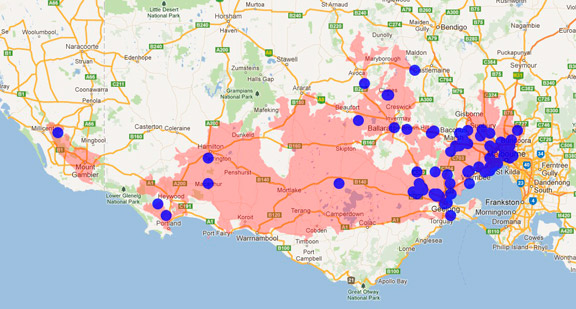A range of teacher professional learning programs will be developed to accompany the Biodiversity of the Western Volcanic Plains online outreach...

Swift Parrot
Lathamus discolor
Roosts communually. Almost always found in trees, only coming to the ground to drink. Breeds September-December in Tasmania. The timing varies with the flowering of the Tasmanian Blue Gum. Nests in hollows in trunks of trees with pairs often returning to the same spot each year. Between 3 and 5 eggs are laid. The females incubate the eggs for 20 days. The male helps to feed the chicks. Chicks leave the nest after 6 weeks.
| Details | Description |
| Type | Bird |
| Group | Parrot |
| Other Common Names | Red-faced Parrot, Red-shouldered Parrot |
| Identifying Characteristics | |
| Distinctive Markings | In flight, the bright, green body, dark flight feathers and scarlet underwing coverts are highly distinctive. |
| Diet | Omnivore. Feeds in the outer canopy of flowering eucalypts, eating mainly nectar. Feeds also on scale insects, seeds and flowers. |
| Habitat | Dry sclerophyll forests and woodlands, suburban parks and gardens. |
| Native Status | Native to Australia |
| Sounds | In flight contact call described as "chi - wit, chi - wit, chi - wit". Greatly varying chatters and trills mixed with deeper mellow sounds and clear, sharp notes. |
| Taxonomy | |
| Phylum | Chordata |
| Class | Aves |
| Order | Psittaciformes |
| Family | Psittacidae |
| Genus | Lathamus |
| Species | discolor |

Distribution maps indicate current and historic locations where species have been sighted.
Source: Atlas of Living Australia
| Conservation Status | |
| DEPI Advisory List | Endangered |
| FFG Act | Listed as threatened |
| EPBC Act | Endangered |
| FFG Action Statement |
The conservation status of species is listed within Victoria and Australia.
The Department of Environment and Primary Industry (DEPI) Advisory List consists of non-statutory advisory lists of rare or threatened flora and fauna within Victoria.
The Flora and Fauna Guarantee Act 1988 (FFG Act) lists threatened species in Victoria. Under the Act, an Action Statement is produced for each listed species.
The Environment Protection and Biodiversity Conservation Act 1999 (EPBC Act) is the Australian Government’s key piece of environmental legislation, listing nationally threatened native species and ecological communities.



